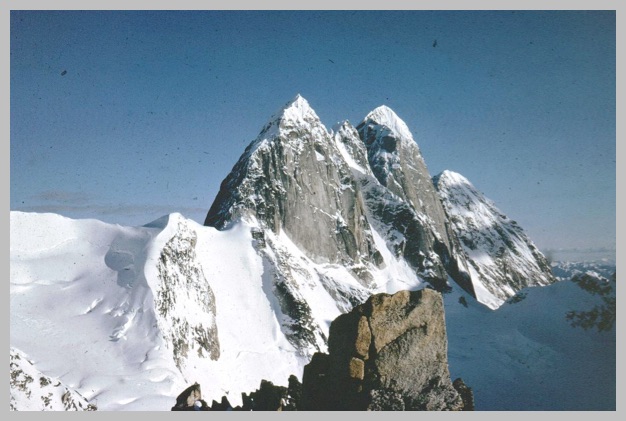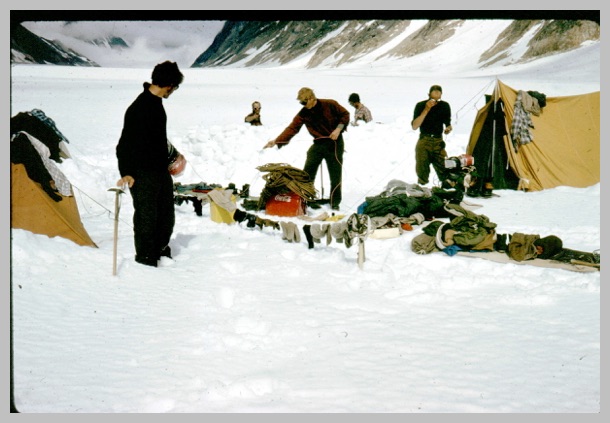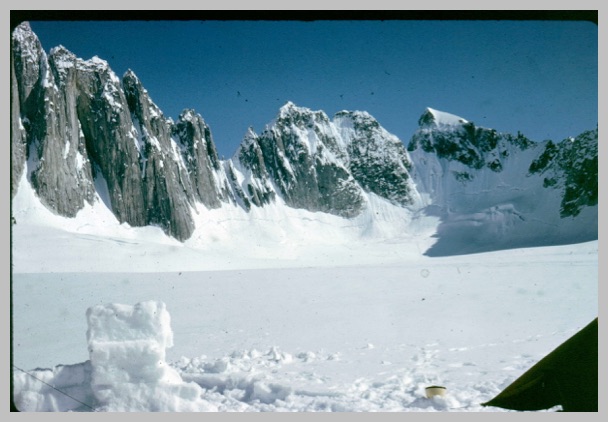The Cathedral Spires
By Alvin DeMaria and Pete Geiser

Cathedral Spires
Three Peaks
IT SOMETIMES happens in life that a practical joke leads to practical results; this article is the brief account of such an occurrence.
In the June, 1962 issue of Summit magazine appeared a photograph of a magnificent group of mountains called the “Riesenstein.” These peaks were of such an unusual character that they aroused an immediate interest. A series of abortive attempts was made to locate the range. A little research showed quickly that the geographical information given in Summit was spurious - Canadian topographic maps did not jibe in all respects with Summit’s geography. Obviously, Summit had fallen victim to someone’s sense of humor. Yet there were the pictures; palpable mountains. They must have some existence. But where? Chamonix? Africa? Asia? The moon ?
Months passed and the “Riesenstein” appeared doomed to join the ranks of other mythical and fabulous regions like Shangri-La and the Seven Cities of Cibola. However, one person did not give up so readily; Al DeMaria continued the search. With patience, perseverance and an unusual stroke of luck, the “Riesenstein” was found. The stroke of luck was supplied by Brownell Bergen, husband of the administrative secretary of the American Alpine Club, who stumbled across photographs and maps showing the “Riesenstein” to be a totally unexplored range of rugged beauty. Although the peaks had a maximum elevation of only eight to nine thousand feet, there was considerable relief as the glaciers were only four to five thousand feet. The mountains were located at the headwaters of the Yentna and Kichatna rivers, some 75 miles west of Talkeetna, Alaska. Their exact position, as the Cathedral Spires or Kichatna Peaks of the Alaska Range, is given on USGS topographic map Talkeetna B-6, Alaska.
This discovery sparked a flurry of activity and Al and Claude Suhl immediately organized an expedition. The group began gathering in New York City, left town on June 18 via microbus, and accumulated additional members on the way. On the evening of June 23 the bus reached Talkeetna after a happily uneventful trip.
The next day dawned rather gloomily, but the weather steadily improved during the day so that by mid-afternoon Don Sheldon could begin the flight. We landed at 5500 feet on one of the large northern glaciers near what appeared to be one of the major peaks in the group. Unfortunately we were unable to get a good look at the southern part of the range as it was pretty well clouded-in at the time. Besides, we reasoned, it would be easy enough to cross from one glacier to another through the various cols seen on the reconnaissance flight. We were in for rude awakenings. The first shock came as soon as Sheldon took off, leaving Al, Pete Geiser and a small pile of gear standing alone on the glacier. The immensity of the walls surrounding them suddenly took on the proportions of an absurd joke. Climb? These walls? Plastered with snow and icy couloirs, rising two to three thousand feet above the glacier, the summits seemed the epitome of inaccessibility. And though, as was to be expected, this view moderated as familiarity grew, it still remained the opinion of all members of the party that these were the most challenging peaks any of us had ever seen. One could place the entire Bugaboo group (the closest analogy to this group) in a single cirque of this Kichatna range As each succeeding flight landed additional members, the same sense of absurdity overcame the new arrivals and the cirque echoed and re-echoed with cries of surprise and awe.

Camp Five
A day was spent in organization and followed by a “warm-up” climb of Al, Pete, and John Hudson on what was obviously the easiest peak in the cirque - Peak 7270 feet on the western rim. The climb on steep wet snow with moderate rock climbing was done in what we were to find was typical Kichatna weather white-out and storm.
The 1500 feet of climbing took nearly half a day, and its severity exceeded our expectations. Much of the difficulty on this and subsequent climbs was due to the rotten character of the snow, which covered the peaks in a thick wet layer. Melting snow had produced a saturated highly porous mass and where rocks were close to the snow surface it became difficult to get a decent belay stance. When this feature is coupled with the structural weakness of the snow (very similar to hoarfrost), progress even on otherwise easy slopes becomes ticklish. The following ten days were spent in attempts to break out of the glacier on which we had landed. Our efforts were discouraging. We explored every col over which it appeared possible to carry loads, in an effort to find one which would have given a reasonable degree of safety and speed. By the end of the ten days we realized we were trapped. In the light of this slowly dawning knowledge we felt that the name “Cool Sac” glacier would be most appropriate. We finally abandoned the idea of setting up camps on other glaciers and decided to be satisfied with escaping from the “Cool Sac” for one day or two-day ascents. Eventually, a route was pushed over the lowest col by rappelling down an extremely rotten couloir, in which we had numerous hair-raising adventures, and where we left fixed ropes. All agreed that this col, although the easiest, was such a horror show that it deserved the name “Gashley Crumb Col.”

Cool Sac Cirque
Although our attempts to establish camps outside of the “Cool Sac” were unsuccessful, the exploration did lead to the discovery of several beautiful peaks. A triplet of peaks immediately grasped our minds. These “Triple Peaks” were a set of beautifully symmetrical summits whose smooth granite walls, surmounted by crests of snow and ice, appeared to have been transplanted from Patagonia. In addition to these superb summits there was a crowd of lesser ones rimming the cirque. None of these had any obviously easy line; each was a challenge of varying difficulty.
The prize of the range lay near the head of the ‘Cool Sac” -Peak 8985 feet, the highest in the cirque. From the “Cool Sac” side there appears to be no route which would be less than a Yosemite V. While the total relief is only from 2500 to 3000 feet, the average angle of its walls exceeds that of Snowpatch in the Bugaboos, to which it is roughly analogous, even having its own snowpatch. Capping off these formidable walls is a summit crest of steep ice and snow, Possible routes on its opposite side were investigated fleetingly on the flight out. The relief is greater on that side but it seems more feasible as the general angle of the faces is slightly less. We all considered this mountain -from a mountaineering as well as esthetic viewpoint -to be one of the outstanding peaks of North America. The succeeding week saw attempts on two peaks. A successful one by Claude, Al, and George Bloom on Peak c. 7900 feet, the most northerly peak on the eastern rim of the cirque; and an unsuccessful one by John, Pete, and Aaron Schneider on Peak 7785 feet near its head. As usual, rain and snow squalls enlivened the day. The ascent of Peak c. 7900 feet gave us some idea of an additional climbing difficulty resulting from present glaciation. The glaciers are on the verge of removing the ridges between the summits and as a result, most ridges are knife-edged. Thus, minor steps on these ridges, even where the angle is low, are frequently hard to pass. The end of the second week was marked by simultaneous attempts on two different peaks. A second attempt was made -by Aaron, Al, and George -to climb Peak 7785, while John and Pete attacked Peak 8520 feet between Peaks 8985 and c. 7900. The former eventually found themselves traversing the 450 summit snow ridge. Constant white-outs and the presence of a large cornice (about whose position they became increasingly curious) necessitated a bivouac. A second attempt, some hours later, was defeated by the rapidly deteriorating weather and they returned to camp to find Claude striving to secure the tents in violent gale-force winds, Meanwhile, back on Peak 8520, John and Pete had climbed seven consecutive pitches, ranging in difficulty between 5.4 and 5.8, on some of the most beautiful granite either had ever seen. The rock of this ridge, which started at a high notch reached by a long snow couloir, was very sound and exceedingly rough. Numerous cracks and nubbins allowed adequate protection. The fifth-class climbing ended at the top of the major step on the ridge; unfortunately it also left them somewhat below the ridge crest. Attempts to gain the crest were hampered by bad snow, unpleasant exposure, and an almost total lack of protection for belayer or leader. The weather had become steadily worse with dark fast-moving cloud banks growing all around. A strategic retreat seemed in order and the last rappel was completed just as the first severe winds and sleet of the storm hit.
The next day-and-a-half was spent indoors as the storm ripped corn snow from the surface of the glacier and hurled it at the tents. At its height one could hear the strange moaning of the wind sounding like a monstrous organ. However, as with all things, storms too must pass away. So this one followed suit, leaving our camp in a flattened state.
The passage of the storm marked a change in the weather and in the final week-and-a-half of our stay, rain, snow and white-out regularly succeeded each other. The sun would now only occasionally break through for a few hours of evening clearing. This was most discouraging and greatly reduced our desire for technical rock climbing, However, John and Pete made another attempt on Peak 7785 and succeeded in climbing it in cloud and drizzle. The thick wet snow and steep traverses, above fractures produced by slab avalanches, kept the climb continuously interesting. Fortunately, the clouds eliminated exposure. By the end of the last week the sun had not been seen for almost eight days, snow was falling fairly continuously, and food was running low. It seemed like a good time to leave, if only the weather would let US. But a clear day finally dawned and Sheldon’s silvery plane, with the noise of an angry gnat, appeared and settled amongst the peaks. Camp was broken, the accumulated trash burned and buried, and the last of the party flown out as clouds and storm began again to reclaim the “Riesenstein.”
Summdry of Statistics.
AREA: Cathedral Spires or Kichatna Peaks, western Alaska Range.
FIRST ASCENTS: Peak 7270, June 27, 1965 (DeMaria, Geiser, Hudson).
Peak c. 7900 feet, July 4, 1965 (Bloom, DeMaria, Suhl). Peak 7785 feet, July 15, 1965 (Geiser, Hudson).
PERSONNEL: George Bloom, Alvin DeMaria, Peter Geiser, John Hudson,
Aaron Schneider, Claude Suhl.
Photos by George Bloom
Peak 8985 Feet in the CATHEDRAL SPIRES.
“COOL SAC” CIRQUE: Peaks 7900, 8985 (with snowpatch), 7600, 7785, 7135 and 7270
(partially hidden).